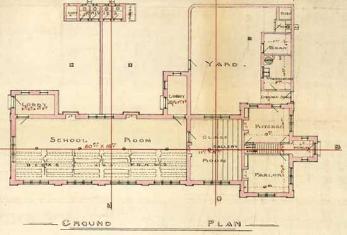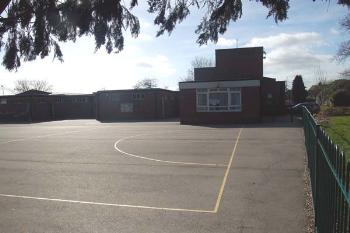Heathfield School Caddington
![Elevation of Caddington Church of England School about 1859 [AD3865/9]](/CommunityHistories/Caddington/CaddingtonImages/ad 3865-9elevation_350x182.jpg)
Elevation of Caddington Church of England School about 1859 [AD3865/9]
Caddington Church of England School was built in 1859. It had a master’s house and accommodation for 146. The buildings stood on the west side of Chaul End Road, south-west of the church and close to The Green on the site today occupied by Cadia Close.
The first Education Act was passed in 1870 (more correctly it was known as the Elementary Education Act). It was a milestone in the provision of education in Britain demonstrating central government's unequivocal support for education of all classes across the country. It also sought to secularise education by allowing the creation of School Boards. These were groups of representatives, elected by the local ratepayers and the Board had the powers to raise funds to form a local rate to support local education, build and run schools, pay the fees of the poorest children, make local school attendance compulsory between the ages of 5 and 13 and could even support local church schools, though in practice they replaced them, turning them into Board run schools (known as Board Schools). Naturally, and luckily for local historians, the Act required a questionnaire of local schools in 1870. Caddington Church School seemed only to cater for boys – schools at Flamstead and Beechwood, accommodated both boys and girls so presumably girls from Caddington went there. The return noted that a 70 place school at Pepperstock was required, as was a 190 place mixed school and a 145 place infants’ school in Markyate Street.

Plan of Caddington Church of England School about 1859 [AD3865/9] to see a larger version please click on the image.
Caddington School Board was formed on 28th September 1875. Caddington church School thus became Caddington Board School. A land mark Education Act was passed in 1902, coming into effect in 1903. It disbanded the School Boards and gave day to day running of education to newly formed Local Education Authorities, usually the county council, as in Bedfordshire. The old Board Schools thus became Council Schools whilst the old National, British and other non-Board schools became known as Public Elementary Schools. Caddington duly became a Council School.
Bedfordshire & Luton Archives & Records Service has a register of Education Inspector's reports for Bedfordshire schools (E/IN1/1) and those for Caddington cover the period 1911 to 1935. The 1911 report states "In a year of considerable difficulty good work has been done in all Classes…and the tone, order and attainments of the children reflect credit upon the Teacher". By 1913 the Inspector reported "The whole of the work bears the stamp of care and thoroughness and order and tone are excellent".
The children sometimes received treats as noted in the school logbook [Micf38/2]: “22nd December 1914: Through the kindness of the vicar and Mr. Brigg the children were given tea on breaking up (for Christmas). Mr. Stewart, a local tradesman, gave an orange to each child”. And later the following year the school was closed on the 21st and 28th July for the annual Sunday school treats.
The first Inspector's report after the Great War, that for 1921, reported some weakness in the reading of the infants but was overall very satisfied with the school, picking out singing ,written work, drawing and PE for special praise. By 1925 the weakness in reading had disappeared but PE had fallen off being "satisfactory as far as it goes, but it should go further, and should be carried on out of doors". The following year the Inspector criticised the smallness of the school garden and the rusty tools noting that only an hour a week was devoted to gardening and only six scholars in the class.
In 1927 the school and school house were valued under the 1925 rating Valuation Act. The valuer considered the school house: "v.nice" it had two reception rooms, a living room and scullery downstairs with three bedrooms above one of which was over the school; also: "There is a small porch in front of house" with a workshop, barn and earth closet outside. Of the school he noted that it had been built for 142 and at present had 108 with an average attendance of about 105 "There are 2 rooms", there was a large brick and slate earth closet in good condition.
In 1928 it was found that "within somewhat narrow limits a very good standard of attainment is reached" reflecting credit on the Headmaster of 34 years, books were needed for the lower years in the school, however. In 1931 it was recorded that staff changes had caused the Headmaster "some anxiety" making class sizes large and giving staffing problems when boys (drawing and gardening) were split off from girls (needlework). Overall the Inspector was very satisfied with the junior school and its Headmaster but of the infants said "The Infant's section is taught on traditional lines but the children have made very good progress". In 1935 it was noted "The Head Master has got a good grip on the problems here, and is well supported by his Staff. The population of the school is migratory; since the 1st January 1934 60 children have been admitted, 32 of whom had been to other schools, and 9 have left again". In one class, as a result of this influx, there were three groups of children each of which had been taught by different methods.
The Second World War brought evacuated children to Caddington. An extract from the school logbook dated 11th September 1939 [Micf38/2] records: "Evacuation of unaccompanied children and adults with children from London has taken place. 96 children with masters and mistresses from Christ Church School Hampstead have been evacuated here". This meant that the school had to find more accommodation and decide how to share the teaching. During the war the school was used as a First Aid Point.
The third of the great Education Acts was that of 1944 which established the principle of County Primary Schools for children up to the age of 11, at which time they took an examination to determine the nature of the secondary school they would attend until they were 15, the most academically able going to grammar schools, the rest to secondary or secondary modern schools. Caddington duly became a County Primary School.
In the early 1950s the decision was taken to close the old school in Chaul End Road. A new school was built on a virgin site on The Green. This became known as Heathfield County Primary School when it opened in 1952.
In the 1970s Bedfordshire County Council introduced comprehensive education, doing away with the 11+ examination and grammar schools and introducing a tier of school between the old County Primary and County Secondary Schools. Thus Lower Schools now taught children aged 4 to 9, Middle Schools from 9 to 13 and Upper Schools from 13 onwards. Heathfield became a Lower School in 1974.
Heathfield Lower School closed on 21st August 2008 when it merged with Willowfield Lower and Five Oaks Middle Schools to form Caddington Village School. The school teaches children aged from 3 to 13.

Heathfield Lower School March 2007